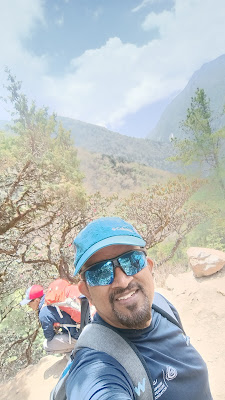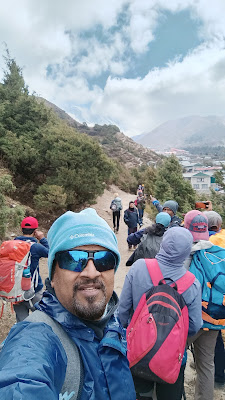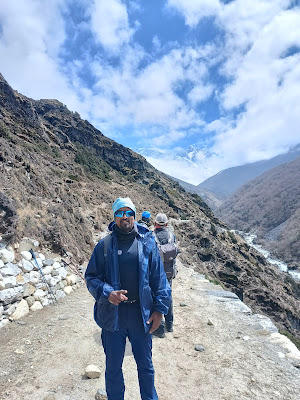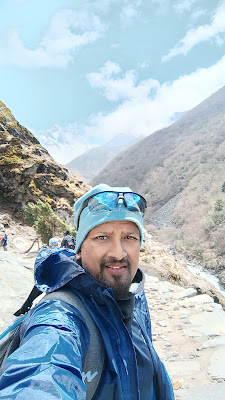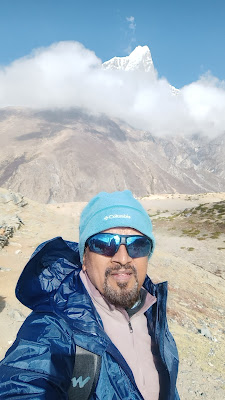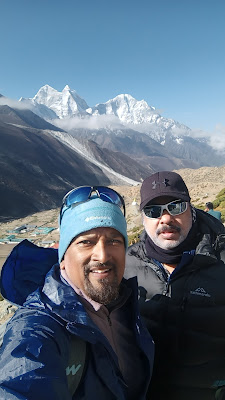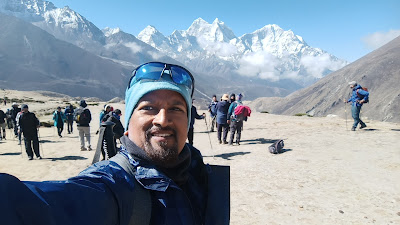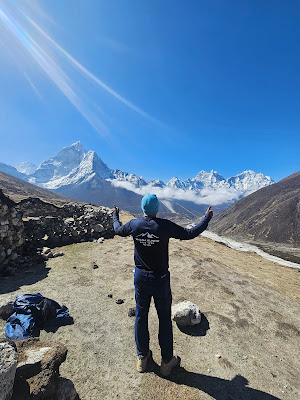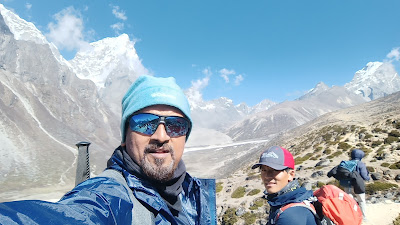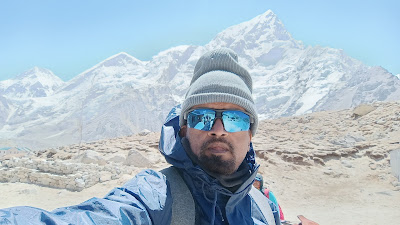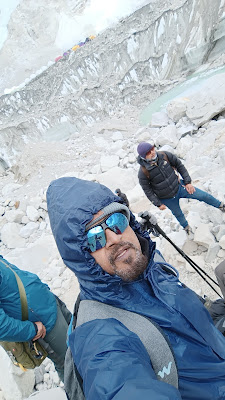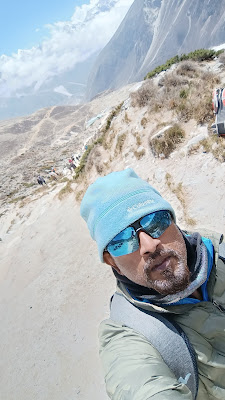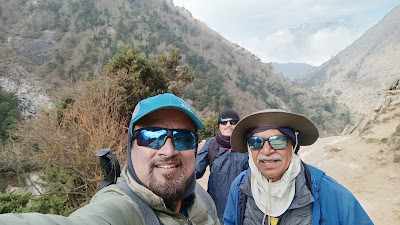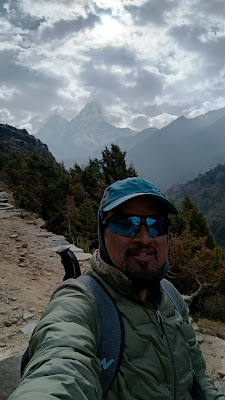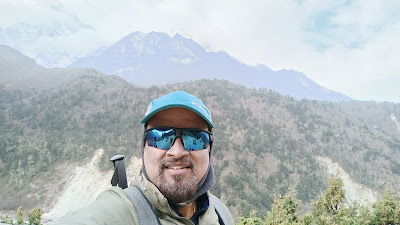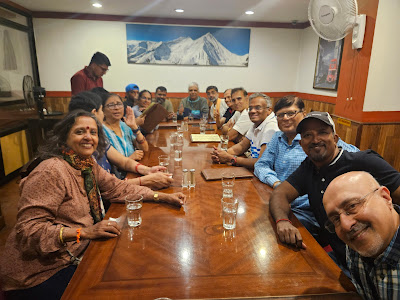Embarking on the Everest Base Camp Trek: A Journey Like No Other
For many, the Everest Base Camp Trek is the ultimate adventure—a dream that lingers in the heart of trekkers, adventurers, and mountain lovers alike. Nestled in the heart of the Himalayas, this iconic trek offers more than just breathtaking views of the world’s highest peak, Mount Everest. It’s a journey that takes you through rugged landscapes, past vibrant Sherpa villages, and into the very soul of Nepal’s rich culture and history.
 |
| Receiving Certificate from Mr. Umesh Zirpe - Head Giripremi |
 |
| View of EBC as I saw it on 14th May |
 |
| Only 7 mountaineers who did entire trek on Foot |
Going through the rugged experience of a Summer Trek (Dhana Kunnu trek) Last May and a winter trek (
Kuari Pass Trek - read my earlier blog
here) last December, I felt I am ready to take my first steps into the world of high-altitude adventures, the Everest Base Camp Trek promised an experience of a lifetime. The challenge of reaching the foot of Everest itself is both physically demanding and spiritually uplifting, rewarding you with stunning panoramas, a deep connection with nature, and a sense of achievement like no other. Enjoy! The tallest mountain in the world is also a treasure trove of life lessons. Here’s an account of a trek to Mount Everest base camp and a fortnight in Khumbu, that changed how I see my life.
 |
| Peak Promotion & Giri Premi at Certification distribution |
 |
| Right about there at EBC. Mt. Everest is seen in the background (small triangle up top) |
The different names its known as Mt. Everest to the world, Mt. Sikdar for India, Mt. Sagarmatha for Nepal & Mt. Chomolungma for Tibet
And then the Summit. Nothing feels heavenly than the sweet sound of success. 12 days of hard trekking and the culmination.
.jpeg) |
| Hot Chocolate for a successful Summit |
From the first steps in Lukla to the moment you reach the Everest Base Camp, join me as I embark on a journey to the roof of the world!
5th May 2025 Day 1: Fly into
Kathmandu. Drive to Ramechaap
I embarked upon a Indigo flight in Hyderabad to Delhi enroute Kathmandu in the wee hours of 5th May. There was a big layover in Delhi so caught up on some much needed sleep at the airport in Hyderabad as well as Delhi.
 |
| T2 terminal - Delhi Airport |
I reached Kathmandu at
around 5PM the same evening. Kathmandu airport is not big but crowded due to the constant arrival of tourists here. Maneuvered through baggage claim, customs and as soon as I felt the open air of Kathmandu, it was just about cold but still sent shivers through my spine just realizing that I am embarking upon every trekker's dream - "The EBC".
 |
| Arrival Lounge - Kathmandu Airport |
The team of Peak Promotion was prompt and Mr. Pasaan found me, garlanded me, and then took me quickly to the "Kailash Kutee" Hotel.
 |
| Welcome by Peak Promotion Team outside the airport |
I met the 24 other participants with whom I would
share this journey to EBC and it created a weird sense of excitement in me. The
participants were mostly near the 50s and beyond. Very impressed with the
septugenerians and their energy levels. All in all a team that was a mix of
enthusiasts, avid trekkers and beginners.
Not to forget, our team of porters –
the unsung heroes of the trek. Carrying our loads, dancing through the trails,
and offering endless encouragement, they were the backbone of our journey.
Together, this ragtag team of trekkers, guides, and porters became a family –
bickering, laughing, and supporting each other as we climbed higher and higher.
And I would not have wanted to do it with anyone else!
 |
| Entire EBC Trek Route Map (Ascent - Black dots, Descent - Yellow Dots) |
6th May 2025 Day 2: Fly from
Ramechaap to Lukla(2840 m)
The Everest Base Camp trek is as
much a journey of contrasts as it is of altitude. It begins with a
heart-in-mouth landing at Lukla – the world’s most dangerous airport. Why so
dangerous? Because the runway is uphill, short and ends in a cliff!
We collected Giripremi T-Shirt and down jackets from peak promotion. We arrived with our duffel bags
though, as our entire luggage wouldn't fit on the tiny plane plus the flight baggage limitations. Started on a
road journey from Kathmandu to Ramechaap. It took us a good 5 hours to reach
there on an extremely bumpy road. Hardly could sleep, yet excited to start the trek. Had a quick packed breakfast and walked a furlong into the ramechaap airport where luck had other plans for the day.
The airport is very small, one runway, three carriers (Tara, Summit, Sita). They fly as if its an emergency, the clouds at Lukla are very unpredictable and the go ahead is for very small windows and as soon as the 'go ahead' comes, the flights just about go crazy, getting in line as soon as they can to get the next set of trekkers to the other side to Lukla.
The small airstrip at Ramechap was all set to
give us the first shock of the trip. The flight to lukla was all based on the
weather conditions that could allow a successful landing on the short strip
that was available. It was a arduous wait for a complete one and half day and
we finally caught up with the last flight on 7th May.
The DHC-6 Twin Otter 300 aircraft
operated by Tara Airlines, which can carry up to 22 people, has a luggage
allowance of 10kg per person. In order to meet that limit, we backpackers had
to be quite creative compared to usual since they only weigh your
backpack at check-in.
Due to several uncontrollable
variables, there is a high chance that the flight might be cancelled. I knew
deep down that I could get stranded at some point, since the flight from
Ramechaap to Lukla is notorious for that, often leaving people stranded for
days and sometimes weeks. As the hour hand ticked from 10
to 11 to 12, my heart started to sink. "My journey hasn't even begun yet,
and I am already stranded", I thought to myself. Then, I shook off the
negative feeling as a friend once told me,
"Nothing works the way it should be in Nepal. Prepare for the worst and
leave wiggle rooms for when that happens."
 |
| Waiting Lounge - Ramechaap Airport |
By 5 PM, I finally heard the
announcement I had been waiting for for 11 hours: my Tara Air flight 153 was finally
commencing and ready to take me to Lukla. I heaved a sigh of relief as I lined
up to get on a small double-turbine aircraft among 20 other excited
backpackers, fully geared up to the tee, ready to trek the Himalayas.
 |
Finally all excited to get onto that flight
|
 |
| Inside that flight |
There are 3 tiny seats on each
row, and there are around 20 people packed inside the small aircraft. The
ceiling of the aircraft is so low that not even the flight attendant can stand
up straight as she goes around checking and giving us candies and making us ready for the take-off. Within minutes, as the howling
engine shook the entire aircraft and the deafening turbines spun vigorously, we
were off the ground. Like any small turbine aircraft, it was impossible to hear
anything, not even your own nervous breathing of anticipation and fear.
As the aircraft pierced the sky,
the scenery shifted from the rustic bustling cityscape of Ramechaap to the
rolling hills of the Nepalese mountains. Within 30 minutes, snow peaks started
to appear outside the aircraft's window. "Finally", I thought to
myself, "this will be the best birthday gift I have ever given
myself."
 |
| Runway View - Lukla Airport |
 |
| Arrival Lounge at Lukla Airport |
As my excitement soared, the
announcement came through the telecom of the open-door cockpit: we were about
to land. As the aircraft pointed its head down towards the mountain, I got a
glimpse of the infamous runway of Lukla airport.
7th May 2025 Day 3: Lukla
(2,840 m) and Trek to Phakding (2,610 m)
We reached Lukla through Tara
Air's last flight at 530 PM local time. It was a first night trek for me and we
started with our head lights on. The trek is a popular first day of the EBC
trek, involving a scenic descent through pine forests and across suspension
bridges. Its a 3-4 hour walk, covering about 10Kms. The trek follows the Dudh
Koshi river and leads to the village of Phakding, where trekkers often spend
their first night. The trek starts with a surprisingly gentle day –
something I’d realise would not happen again! The trek was mainly downhill,
something that filled me with dread knowing we would need to retrace our steps
on the final day! It gave us the perfect chance to ease into the rhythm of the
mountains and get to know our fellow trekkers.
 |
| Trek Start Point - Khumbu Lodge in Lukla |
The trail passed through
villages, bustling with life. We passed our first donkey caravan, their bells
echoing through the valley. The Khumbu region unfolded before us: prayer wheels
spinning in the breeze, children laughing, and porters carrying impossibly
large loads with an ease that would put my laboured breathing to shame in days
to come.
We stopped by for a quick lemon & ginger tea at Sherpa Coffee. This tea became our staple drink across the entire trek and its one thats suggested one too. We sat in the open and enjoy beautiful pine views of the Khumbu valley.
 |
| Dikki from Peak Promotion as Trek In-Charge |
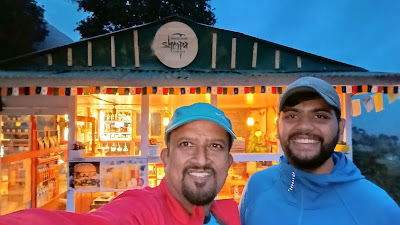 |
| Ashish from GiriPremi as Trek Lead |
By the time we reached Phakding, it became apparent that we had very different paces in the group. We weren’t a team just yet, but we would soon become one hell of a close knit one! We spent
our first evening in the communal area, swapping stories and laughter with
other travelers while keeping warm by the fire. If only I had known then just
how cold it was going to get the higher we went!
8th May 2025 Day 4:
Phakding (2,610 m) to Namche Bazar (3,440 m)
The day started early with a tasty breakfast. Quick warmups by Ashwini and Prayers by the ladies. The warm ups and the prayers at the start of trek each day became a ritual for the team.
This was the longest day in terms of distance - 16 kms and a strenous one too.
It was long and tiring, with some long, steep climbs yet something that set the tone for the entire trek. As long and strenuous as it might seem, you can't ignore the beautiful mountain ranges and the different tricky suspension bridges that came along the way. Hillary bridge presented itself to be the longest of these. The organizers had already arranged permits for the Sagarmatha national park.
 |
| Hillary Bridge |
 |
| Everest Bungee Jump Bridge |
Trails along the Everest Base
Camp are often quite large, as the trail has become more and more
commercialized over the years. In 2019, there were over 40,000 tourists
traversing this trail alone in Nepal. As more and more people travel the route,
businesses in the Sherpa's capital of Namche Bazar also grew. In order to
sustain the booming tourism industry at 3,800 meters above sea level, supplies
and logistics are the lifeblood of the economy up there.
These porters and their mules
handle the logistical part of this economy. Many times on my way to Namche
Bazar, the trail often comes to a complete halt as the porters slowly lead
their livestock along one of the many suspension bridges across the valley one
by one.
As an observer and outsider, it
was fascinating to see the organization and management required to put this
livestock in line. However, as a hiker, it can be quite dangerous sharing the
trail with several mules strapped with 2 large gas cylinders on their sides.
As with most animals tamed in
this way, when they walk, they are often unaware of the objects they are
carrying. Therefore, when they pass you, it is your responsibility to dodge
whatever comes your way.
I learned that whenever I am
sharing a trail with an animal, I will always stick to the mountainside no
matter what.
We reached Namche Bazar about 4pm in the evening. We put up at Khumbu Lodge for the night. Namche Bazar is the most astonishing market with shops that include all major brands including Columbia Sportswear, North Face etc.
9th May 2025 Day 5:
Namche Bazar (3,440) to Khyan Juma (3,500 m)
There was a very active buzz in the group. All geared up for the trek ahead as you would understand that we were getting used to this now. Long treks, uneven surfaces, unending ascents and beautiful trails were going to be part of out everyday itinerary. The general concept for any trek is to climb high but sleep low. We enjoyed the beauty of the KhumSerku peak.
We stopped by the Sagarmatha Next, a project and museum that was an eye opener at a different level. It was funded and constructed by the foundation to preserve the local culture and traditions of the Khumbu region, which is facing imbalances due to rapid increase in tourism.
The museum is part of larger initiative to create centers that address challenges in mountain areas and inspire change. We were audience to a move regarding the organization and its work. Also the different products that they create out of waste. A virtual reality view of Mt. Everest expedition was also available.
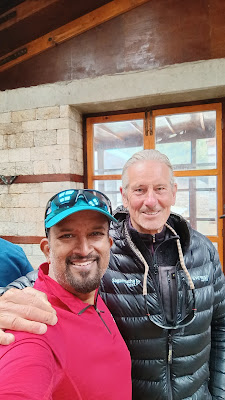 |
| With Head of Sagarmatha Next Museum |
We ended up learning a lot about their green initiatives. Collection of garbage all across the EBC trek route and keeping the environment garbage free.
We continued our ascent to the Hotel Everest view from here on, just to get the best view of the Everest peak from 3800m.
We walked through huge plain meadows and the views were there to be registered. I spent some time gazing at them as if to capture these images in my mind and carry them back home.
e We reached Everest View Hotel around 12 Noon but we missed the clear view of Mt. Everest due to the cloud cover. However, the views from the hotel's view point were still breathtaking none the same.
The Hotel offers some of the most stunning views of the Himalayan ranges in Nepal.

Fellow trekkers had hot chocolate some coffee and snacks, I gave it a skip as I was already overwhelmed by the beauty of the views that the hunger prangs had taken a back stage.
The trek offers access to a wide variety of flora and fauna. Some captures are illustrated below
We were trekking further to get to have our meal as it was lunch time but before that we stopped by at the monastery and paid our prayers.
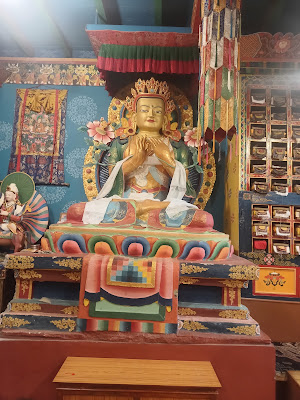 |
| Deity inside the monastery |
 |
| with the Head priest |
Had the standard Thakali thaali for Lunch. It's the staple food of all Nepalis and generally suggested to have during the entire duration of the trek.
Balanced meal with right amount carbs/vitamins.
Good singing session here by all participants. Jayashree mam sang a Lord Shiva song in the most outstanding fashion.
After lunch, we started our descent down to the hotel where we would spend our night in Khyan Juma. it was the Ama Dablam Hotel. Still trying to synthesize the moments of the day, little did I realize/expect the surprises that awaited me at the Hotel.
The trek lead/team surprised me with a small birthday party.
All in all the entire day culminated in a very lovely and dear to my heart celebration of my 53rd birthday.
10th May 2025 Day 6:
Khyan Juma (3,500 m) to Dabuche (3,728 m)
As usual, an early start and we had our breakfast in the open. This view point has one of the best views of Mt. Khum Serku, Mt. Ama Dabolam, Mt. Cholache, Mt. Lhotse Mt.Nuptse

The Trek was pretty much a very short one. We stopped by the Everest Lodge for a quick Lunch. We climbed up a steep ascent at Tengboche and stopped by a monastery as well.
The day was bright and we did find a little rain on our way just before arriving at Dabuche. It was a very lively descent through meadows, pines and paved pathways.
we spent our night at paradise lodge in Dabuche. The size of the rooms started to decrease as we gained altitude.
11th May 2025 Day 7:
Dabuche(3,728 m) to Dingboche (4,400 m)
Day 7 of our trek started on a cold and cloud Sunday morning. An additional layer of clothing had found its way onto our bodies. We had very clear and good views of Ama Dablam with peek-a-boo views of Mt. Everest at different places. The Inja river was giving us company all along. It was good long 10 Km trek through trees and forests. As we moved into the afternoon, the weather turned a little bit on the colder side.
 |
My Lead, My photographer - Raj
|
we stopped by at Everest Kitchen for a sumptuous lunch and moved forward to our destination at Dingboche, where we reached by 3 in the afternoon.
 |
| Our first views of Mt. Everest |
Our first views of the actual Mt. Everest started from here.
 |
with Mr. Anthony from Australia
|
More views of Mt. Everest with participants.
More views with other trek participants and finally at the Everest Kitchen for our lunch.







I continued to have the same Thakkali Thaali and it was as good as it gets. Proceeded further to the plains from which you could see the entire of Dingboche village. Huge expanses of land and houses could be seen and the tall and long stretch of Pine trees started giving way to smaller and smaller bushes.
 |
| Inside the restaurant |
 |
| Lodge runs on Solar panels. "Sun never bills" |
For the first time during our trek, we had oxygen level checks. Unfortunately, we saw Kumar and Jayashree(Couple from Dubai) not able to continue the trek and had to return back by Helicopter the next morning. To our surprise, even Mr. Girish had to return back due to health issues.
12th May 2025 Day 8:
Acclimatization Day in Dingboche(4,400 m) to Nagarjuna Hills (4850 m)
Today was an acclimatization day at Dingboche. There were additional peaks that came into my pictures, the likes of Island Peak, Lhotse, Ama Dablam from a
new angle and much more. The actual joy of trekking in its purest form.

We started a little late today as we only had to ascent close to 400m over Nagarjuna hills to get ready for the steep climb to Lobuche. Nagarjuna Hills is marked by a White flag every 100m. We were asked to at least go to the 2nd Flag and 3rd Flag would be better if we could climb up there. I and Nithin climbed up till the 4th Flag and it felt good up there. Lot Cloudy up there and most of the views went blurry within a few minutes. Very windy and the chill quotient also had gone up.
 |
| Good steep ascent to Flag #1 |
Very windy conditions. Clouds were all over. Trek Lead cautioned that there might be some rain. We slowly moved forward for the next Flag.
 |
| Flag #2 |
Extremely Windy conditions. Felt chill and the down jacket from Peak Promotion kept it comfortable to continue ascent to next stage





 |
| Flag #3 |
Raj asked me if I want to proceed. I said, lets go. This was one of the fastest move up to Flag #4 since it was getting cloudy and windy as never seen before.
 |
| Flag #4 |
We quickly clicked some pictures and started our descent. Happy to have felt normal at 4800m, more confidence for higher climbs up for the next day. During the descent, caught up with rest of the trek participants at Flag #3 and below



We were back after this acclimatization trek before 12 noon.

It was a rest day and our trek Lead had mentioned cafe 4410 - as the place to go. Me, along with Sanjay and Arun went there post lunch and no two thoughts that it was a good decision. The Cafe felt like any modern cafe in a town, visitors were mostly foreigners and menu was extremely expansive. We had hot chocolate and some green tea, carrot cake for the side.


 |
| Nepali kids are just toooo cute |
This was the first night that we had longer time to sleep through. It was colder, yet I guess the idea of 2 more pushes for Summit kept me more motivated than any other time during this trek.
13th May 2025 Day 9: Dingboche
(4,400 m) to Lobuche (4,940 m)
Penultimate day to Summit was marked with early start as usual. Steep climb awaited and of course long trek for sure.
We stopped at Best Point Cafe for our Lunch. Its just across the River basin that we crossed over via an iron bridge. Completely Rocky or should I say full of boulders.
We climbed up the Dugla hill to hit the famous Sherpa museum. Primarily a cemetery put together in memory of all sherpas who have lost their lives and whose body has not been found.
 |
| See the Prayer Flags |
 |
| See the Stone formations |
The cemetery is combination of stone formations(stacked over one another), Plaques installed into rocks, Prayer Flags all over. Windy yet subdued place with one of the best views across the valley and rocky peaks(Lhotse, Mt. Makula, Ama Dablam) protruding into the sky above.
We climbed for about 10 kms through extremely sunny and dusty weather in approximately seven hours. Three of us arrived a lot earlier than other participants into Lobuche waited eagerly for others to come in.
 |
| View from Lobuche Hotel |
14th May 2025 Day 10: Lobuche
(4,940 m) to Gorak Shep (5,170 m) to EBC (5,364 m) and back to Gorak Shep
(5,170 m)
We started early as usual with the excitement that the end was in sight. Little did we realize that this day's trek would be the most gruelling. As much as the long steep climbs were involved, the complete dry rocky dusty terrain will add it to the complexity. It was a walk through complete plains, muddy paths, hardly any trees, completely spread out with bushes.
While at this stretch, one of the trek participant Seshadri felt unconscious and had to return back to Periche. We were now trekking with four less participants. The walk through Moraines(rocky remains after glacier meltdowns) make it harder for the mind to relax, far long stretches of rocky terrain creates a sense of fatigue, demotivated mind - all in all a not very supportive environment.
We travelled close to 5Kms but it felt like eternity, primarily because of the ascents and descents in quick succession and that too at least seven at a stretch. We had already taken 4 hours for this short distance. By the time we reached Gorak shep, which is the
older base camp (we had already crossed the 5000m mark with this), it was 12 noon. We stopped by at the Hotel for quick lunch so that we can go for summit push post lunch. We just realized that another participant -Ashwini: had given up due to ill health. Felt sorry for five of our beloved trekkers to not have live the complete EBC dream.
 |
| Chatrapathi Shivaji statue erected by Giripremi at the Entrance of Gorak Shep hotel |
 |
| That's Everest in the middle |
The views got more and more breathtaking, the landscape changing dramatically from a dull brown to an icy white. We saw the Khumbu Ice fall, a large glacier that runs all the way separating the base camp from the rest of the path to the summit.
It looked fascinating, from a distance, of course. But our journey would end here at the base camp.
Ironically, the base camp, although would bring us close to Everest, it would also cut us away from the beautiful views of the peak that we had so eagerly sought. The peak gets completely covered by the strong and protective twins Nuptse and Lhotse. We knew that it is there somewhere beyond, but we could not see it!
See the entire video of EBC here as seen by us when we visited it
And we looked at each other and
smiled with exhilaration, Hugs of making up to it , high-fives, taking photos
against the peak in the background. It was a poignant moment, my mind was
completely at peace. I was overcome by a sense of humility and respect towards
these mountains.
There are several blessings in
our life that we take for granted. We tend to complain about trivial
discomforts like a coming late, traffic jams, power cuts , work issues and
small difficulties.. And we conveniently assume that we have a fundamental right
over creature comforts, and so easily take for granted what is made available
to us mostly due to the fact that we were born in a certain place at a certain
time.
While we were walking, we had to
exert our bodies to great limits. We had to push it beyond our normal physical
abilities and cajole it to move at great altitudes.
15th May 2025 Day 11: Gorak
Shep (5,170 m) to Pang Boche (3,900 m)
After one of the most satisfying and cajoling sleep last night. We were only seven overall left who were taking the long descent down on foot. Most of the trekkers had flown back to Kathmandu via helicopter from Gorak shep.
 |
| The Final seven descent on Foot |
We met Nikunj Shah (Lead for the 2nd EBC trek group of Giripremi which was travelling one day behind our group) on our way here.
The descent down was long and never ending. We were also trying to catchup on the lost day in Lukla so about 60+ kms to be covered in next 3 days.
We stopped by for lunch and probably for the first time we ate to our heart content.
Most of this descent was on plains and it was long walks primarily around mountain slopes. We reached Pangboche around 5 pm and checked into Hotel Om Kailash. We ate a quick dinner. I am pretty sure we seriously slept like logs that night.
16th May 2025 Day 12: Pang
Boche (3,900 m) to Monjo (2,900 m)
As usual the trek started early
as we had to cover about 23 to 25 kms down to Monjo. A long, and arduous
descent, however laden with a couple of ascents at Namche bazaar and Tengboche.

Seshadri sir finally joined the trek from Periche. He was so happy to be back, hopefully had left the bad memory of the earlier two days behind.
We reached Namche Bazar at little over 3 pm. Dikki took us to her Sister in Law's(Husband's sister) place and as promised served us fresh made hot Pakodas with Tea. This was promised as a reward for our successful trek. It was one of most tastiest Pakodas we had.
 |
| Pakodas at Dikki's Sister in law's place |
 |
Outside Dikki's Sister in law's place
|
It was a comical event that
stuck with the entire descent group for the rest of our trek. The main actors in
chief were the mules that were coming in opposite direction to our descent. And the number of mules
was never ending. However, after all the mules passed us. There was only one that was left behind and who went
braying behind others - running as much harder for others as if he was calling for his friends to
wait for him.
Me and Ashish(our Trek lead)
just mimicked the same for rest of our group and yelled - "Doston
Ruko(Friends, Wait)". All the participants turned back and we laughed our
hearts out as we were the only two who knew what was comical in the scenario.
We reached Monjo at around 5 pm and were tired to say the least. We stopped by at the Panorama Lodge and resort. Prabhakar sir was my roommate. This room had an attached toilet. We waited for rest of the team to come in. A little worried for Sudha maam and Badami sir. They came in 2-3 hours later, a sigh of relief.
17th May 2025 Day 13: Monjo
(2,900 m) to Lukla (2840 m)
The trek from here on till Lukla was not a long one. The day started a little late as we were not covering a lot of distance today. We had breakfast and some group photographs of the famous seven of this trek as were at the helm of completing the last leg of our long, strenuous yet rewarding EBC trek.









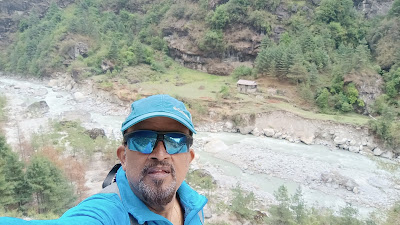
We stopped by at the Hotel Himalaya Lodge for Lunch
and I wouldn't shy away from committing that it was one of most tastiest lunch
of this entire journey. While we were having lunch, it started to rain and we
had to complete the rest of trek in wet conditions with slight drizzles
accompanying us till Lukla.
There was a sense of relief that the trek was finally over. We were stationed back at the Khumbu lodge in Lukla where all of this started in the first place. Nothing would have been possible without the support and encouragement of the Giripremi and Peak Promotion team. They were there right through the entire journey.
The Night was a mix of tasting some local alcohol and obviously the celebrations along with all the porters and staff, dancing to the local tunes of Nepal and how could you miss Bollywood songs. There were multiple groups in the restaurant who had completed EBC so we all danced together celebrating the success.
18th May 2025 Day 14: Lukla to Kathmandu & Shopping
We were asked to have our breakfast early because the unpredictable nature of outbound flight from Lukla to Ramechaap. We were still having our breakfast when Dikki came in running and announcing that the there was a space for four people on the next flight leaving out of Lukla in the next 15 minutes. Four trekkers rushed out of the airport. We also fast tracked our way to the airport and waited with bated breath as to when would we be boarding our flight.
After about an hour, our chance came and to our surprise we were flying back to Kathmandu instead of Ramechaap (Avoiding the 6 hour road journey). Thanks to the organizers to have saved us the pain of the road travel. We were all happy to back in Kathmandu. Our Van took us back to Krishna Kutee Hotel where the entire team got together again.
I took some time re-arranging my luggage. Took a much required refreshing bath (since I had not bathed since 6th May). It was raining heavily but I and Ashish went out for a lunch at a local restaurant. Very modern setting with live band set up as well. Ashish helped me with local shopping for T-Shirts, Jackets, memorabilia etc. Manjunath joined us half way through during shopping. We came back to our hotel room.
The entire team decided to have a celebration party for our successful attempt and we went to a restaurant of Ashish's choice - Gaia Restaurant and Coffee Shop. We ate to our heart content and returned back to the hotel by 10 Pm.
Ashish announced the certification distribution ceremony would happen at 1030am the next day at the Hotel.
19th May 2025 Day 15: Local
Tourism in Kathmandu
I got up very early because I wanted to go around kathmandu city and return in time for certification distribution. I had to visit the famous Pashupathinath temple(Jyothirlingam) and Guhyeshwari temple( Shakthi peetha) for sure. I used the local bike rides provided by InDrive to cover the tourists spots.
 |
| Entrance of Pashupathinath Temple compound |
Its a huge temple compound. Multiple shiva lingas, multiple temples. The places buzzes from very early in the morning. Devotees flock in huge numbers and that too on a Monday morning.
 |
| Pashupathinath Temple entrance |
I had a wonderful darshan. I thanked the god for looking over my well being through out the trek. You could worship the main deity from four doors which are placed on four sides of relatively square main shrine. Photography is prohibited inside the shrine.
Both the Jyothirlingam and Shakthi peetha are connected via a bridge over the Bagmati river.
 |
| Way to Shakthi peetha |
I crossed the river to enter another bunch of multiple temples on the other side of the Bagmati river. These temples were surrounding the main shakthi peetha.
 |
| Way to Shakthi peetha |
While I was climbing the stairs, I was motivated to join the Cadets from British Cadet corps(of course Nepalis) who were doing their morning drills - running up and down the stairs multiple times.
I was really surprised that the entrance of the shakthi peetha was a very small door. Pilgrims enter the main compound and then enter the main shrine through an even smaller door. You end up on something like a balcony and the deity is basically spread out on the floor(in the form of Rectum). No Pooja, no offering just a quick prayer and you are done.
 |
| Entrance to Shakthi peetha |
 |
| Buddha neelkanth temple!! Stunning Mahavishnu on Adisesh in full glory! |
I quickly took the ride back to the hotel well in time for the certification distribution ceremony.
20th May 2025 Day 16: Fly back
to Hyderabad, India
Kathmandu airport is small and a chaos. Nothing is in order. Somehow went through check in and ready for the journey back to Hyderabad.
A snap that sums up the hills, the feelings, the effort, the grit, the determination, all put together.
It was one long arduous journey. It felt never ending. May be fatigue or me being impatient as usual to hang up my shoes but I cant appreciate the awesome welcome my family had planned at my residence. Celebrations galore !!! that too at midnight.
 |
| Welcome ritual into the house was breathtaking |
 |
| Emotions outpoured |
 |
| Love my Wife's ecstasy |
A Celebration with family is second to none. And once you see them feel ecstasy, your happiness feels no bounds. Such was the welcome and I once again felt a flurry of pride travel through every nerve of my being. Here is an ode to the epitome of difficult trek that's EBC : Yes I made it through.
The below sums up my trek in one of the participant's - Girish's words
वेणू भाई सोते चलते उठते लगते ट्रेकर कम , सैनिक ज्यादा, जबरदस्त।
चुस्त , दुरुस्त और मस्त, कभी नहीं होगा उनके उमंग और उत्साह का अस्त ।।
वेणू के इरादों को अड़ंगे, अड़चन, कठिनाई, कुछ भी, कोई भी नहीं कर सकता पस्त ।
सारा काम अनुशासित, शब्द नहीं कर्तृत्व , कथनी नहीं करनी , ये अपने लक्ष्य में रहते हैं मस्त ।।
मैं इन्हें soldier Trekker की उपाधि देना चाहूंगा !!!






.jpeg)
.jpeg)


.jpeg)

.jpeg)






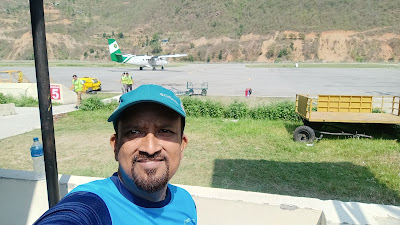









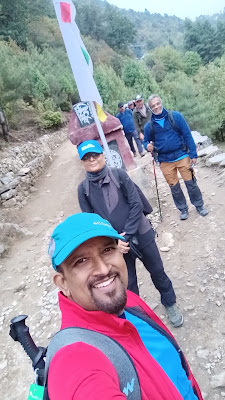







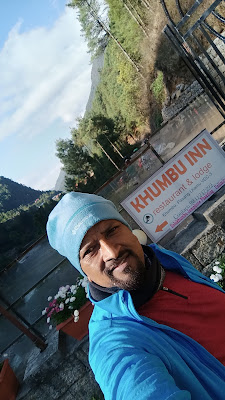










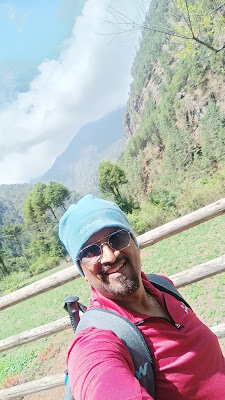















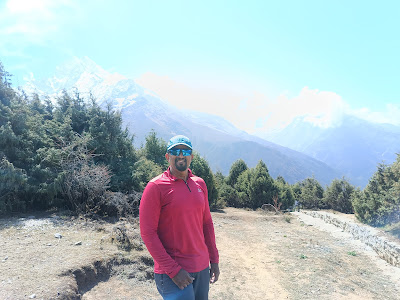



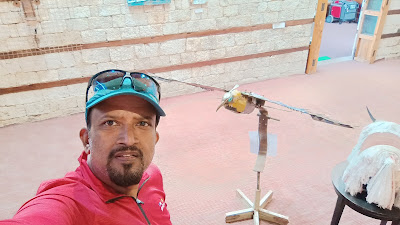

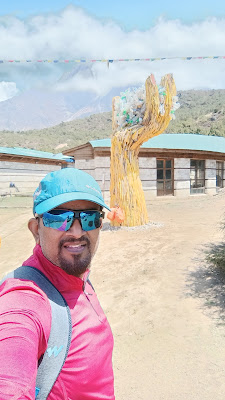




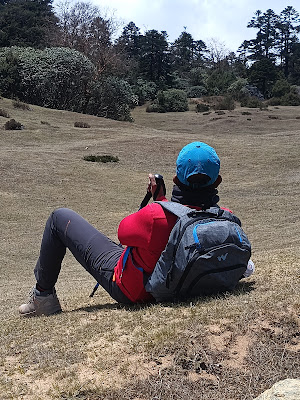


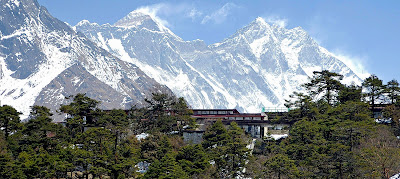




























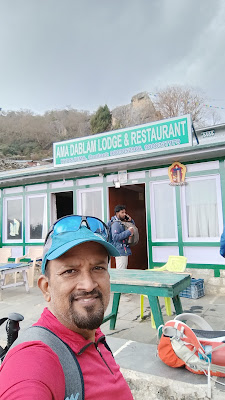

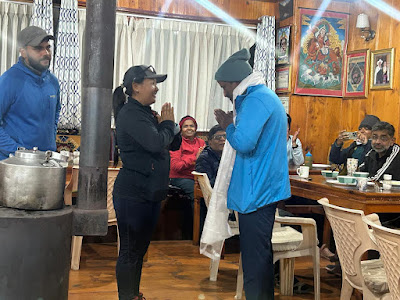
.jpeg)





















